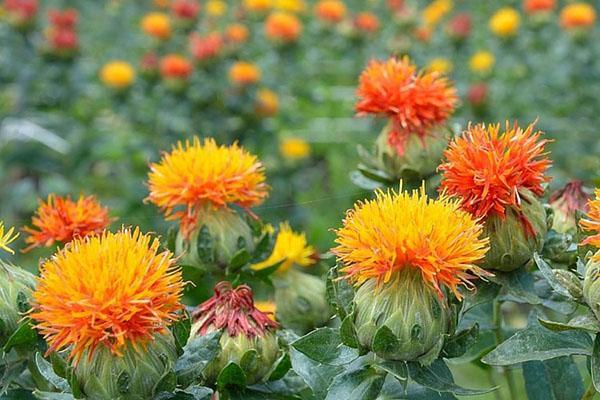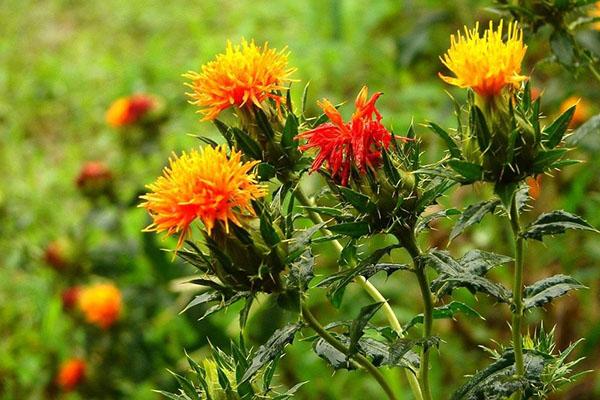Safflower application: what are the benefits of using it
 The use of safflower has a rich history. For a long time, the brightly colored flower has been used to dye tissues and improve the functioning of the digestive system. With the study of the beneficial properties of the herb, the scope of its application has also increased.
The use of safflower has a rich history. For a long time, the brightly colored flower has been used to dye tissues and improve the functioning of the digestive system. With the study of the beneficial properties of the herb, the scope of its application has also increased.
Description and composition

The most popular name is Safflower Dyeing. In addition to it, the following names can be used: wild thistle and American saffron. The genus Safflower has about 20 varieties, but only one has a practical application - safflower dye. It withstands dry periods, does not require sophisticated growing techniques, and does not dramatically deplete the soil.
Natural red and yellow dyes are obtained from the flowers of the plant. They can be used not only for dyeing fabrics, food products, cosmetics. The disadvantage of natural paint is instability; under the influence of sunlight, the pigment quickly loses its brightness and richness of the shade.
This plant is considered a weedy plant, but it can be grown on purpose.
The culture grows well in warm climates in some regions of Russia, America, Egypt and other countries. The plant is used in folk medicine, medicinal teas, honey are prepared from it, and vegetable oil is obtained.
The beneficial properties of safflower are due to its rich composition:
- trace elements (potassium, calcium, magnesium and others);
- vitamins (A, groups B, C, E, D);
- fatty acid;
- glycosides;
- flavonoids;
- lignanan alcohols.
The high fat content (38%) gives the plant a high calorie content. In addition, it contains a lot of protein and carbohydrates. Despite this, safflower tea has a low calorie content, and the concentrate and plant oil are used in small quantities.
In eastern countries and in ancient times in Russia, saffron flowers were substituted for saffron when preparing dishes.
Safflower applications

The composition of the plant allows it to be used for various pathologies to maintain health. Traditional medicine uses:
- flowers;
- butter;
- concentrate;
- cake;
- seeds.
The ground seeds added to the shampoo are an effective treatment for hair loss.
Safflower tea
 Brewing tea from the flowers of the plant will help improve the condition of many diseases.
Brewing tea from the flowers of the plant will help improve the condition of many diseases.
The active substances found in the plant act as follows:
- strengthen the immune system;
- normalize blood pressure;
- reduces weight;
- improves blood circulation;
- used to treat the digestive system, kidneys, liver;
- gives a diuretic effect;
- has a mild laxative effect;
- used in complex therapy for psoriasis and malignant neoplasms;
- stimulates the brain.
Making tea is very simple:
- A quarter teaspoon of dried flowers is poured into a cup.
- Boiling water is added.
- Infused for about 30 minutes.
They drink the prepared drink mainly at night. You can supplement the course with a couple more cups of tea during the day. When using fresh petals, 3 to 9 pieces are enough for 0.5 liters of water. This amount will be enough for the whole day, dividing it into 3 doses at regular intervals.
The safflower petals in tea should not be mixed with other herbs or regular tea leaves.
Safflower honey
 Derived from safflower honey - rare and valuable, since the plant is not a honey plant, and little nectar is formed during flowering. The healing properties of safflower honey are associated with the entry of nutrients and vitamins into it. Among them: PP, C, E, calcium.
Derived from safflower honey - rare and valuable, since the plant is not a honey plant, and little nectar is formed during flowering. The healing properties of safflower honey are associated with the entry of nutrients and vitamins into it. Among them: PP, C, E, calcium.
The use of honey can be topical and oral. It is shown for such violations:
- sleep disturbance;
- sore throat;
- burns;
- arthritis;
- cuts;
- dermatological pathologies.
In cosmetology, the use of safflower honey is associated with the stimulation of hair growth, strengthening the hair follicles when exposed to the scalp. Also, honey can be added to masks to improve hair condition.
Honey is an effective and affordable means of maintaining immunity. To do this, after waking up, it is enough to drink a glass of water with two teaspoons of honey diluted in it.
Using cake
 Safflower is also used as a forage crop along with other feed and yourself. Safflower cake contains starch, protein, oils necessary for animals.
Safflower is also used as a forage crop along with other feed and yourself. Safflower cake contains starch, protein, oils necessary for animals.
The cake has a bitter taste, so animals are transferred to it gradually, giving them the opportunity to get used to new food.
Safflower oil
 This product can be purchased from pharmacies, supermarkets and aroma oil departments. Safflower oil fights body fat and lowers blood sugar. In the food industry, it serves as a raw material for the manufacture of margarine. It has no pronounced taste, smells like flowers, transparent.
This product can be purchased from pharmacies, supermarkets and aroma oil departments. Safflower oil fights body fat and lowers blood sugar. In the food industry, it serves as a raw material for the manufacture of margarine. It has no pronounced taste, smells like flowers, transparent.
Only fully ripe plants are used to obtain the oil.
The properties of safflower oil allow it to be used in dietary nutrition:
- to deal with extra pounds;
- with diabetes mellitus;
- to improve the condition of the skin.
The use of oil in cosmetology is due to its beneficial effect on the skin:
- nutritious;
- improving blood circulation in tissues;
- softening;
- moisture-retaining;
- anti-inflammatory;
- strengthening.
In addition, it serves as a conductor that delivers the active components of other agents to the deep layers of the skin.
This allows you to apply the tool as follows:
-
- Use for massage (for dry skin).
- Apply to aging face skin.
- Use undiluted for rosacea.
- You can enrich hair care products - shampoos, masks. A tablespoon is enough for 100 grams of product.
- Add to sunscreens.
Safflower oil can be used in cooking - for dressing salads. In terms of its taste, it is similar to sunflower oil.
Concentrate
 Safflower concentrate is used in small quantities. For prevention, it is enough to drink 1 tablespoon daily.
Safflower concentrate is used in small quantities. For prevention, it is enough to drink 1 tablespoon daily.
Contraindications to use and side effects

Products containing safflower are not shown to everyone. They are contraindicated in such conditions:
- pregnancy, since safflower can cause premature birth;
- uterine and other types of bleeding (since the plant thins the blood);
- individual intolerance;
- exacerbation of diseases of the digestive tract.
The peculiarity of introducing safflower into the diet is its poor compatibility with many drugs. When taking anticoagulants, it should not be eaten. Safflower honey, tea oil and flowers are not only beneficial but can be harmful.
Possible side effects:
- Frequent urge to urinate, even with an empty bladder
- allergic rashes;
- malfunctions of the gastrointestinal tract and others.
If the use of this product has led to side effects, then it is better to refuse it and consult a doctor.
The use of safflower has a long history - more than 3,000 years. The plant is widely used in folk medicine for the treatment and prevention of diseases, as well as in cosmetology and dietetics.